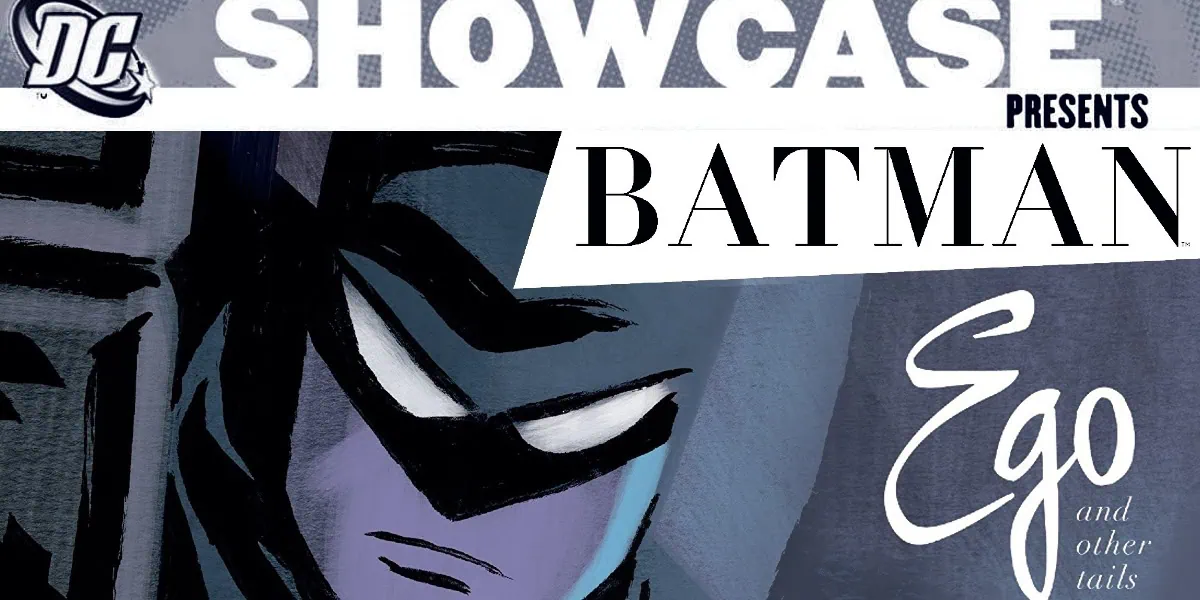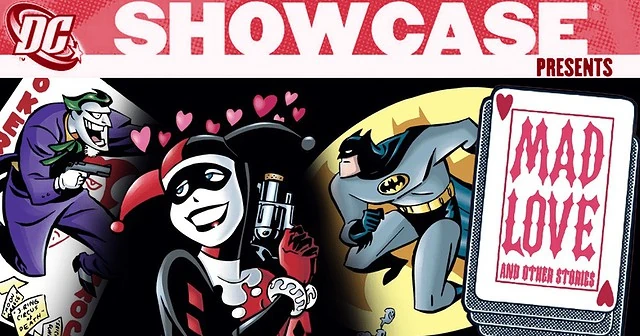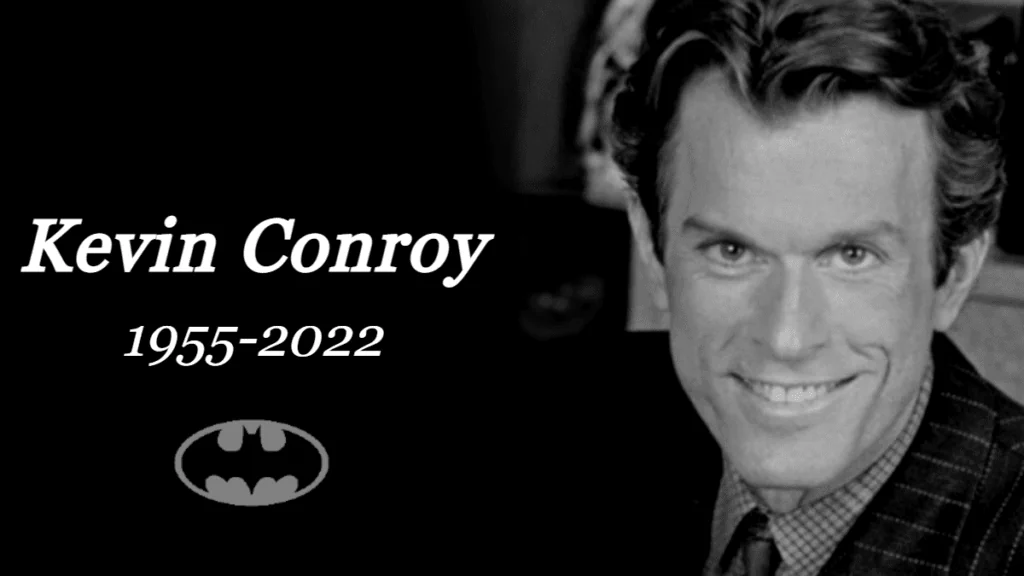Batman: Ego is one of the most important Batman character studies of the past twenty years. The 64-page prestige comic was the first comic written and drawn by legendary artist Darwyn Cooke, who started as a storyboard artist for the Batman/Superman animated series.
After Ego launched his comics career, Cooke would go on to win 13 Eisner Awards in just a few years, crafting some of the most artistically distinct DC comics of the 2000s including Batman: Ego, DC: The New Frontier, and the modern reinvention of Catwoman. Coming during a time when “dark and gritty” storytelling was the standard, Cooke’s bright, cartoony art style paved the way for retro-style artists like Doc Shaner and Chris Samnee.
Created as part of Cooke’s job pitch for Batman: The Animated Series in the 1990s, Ego has endured for decades. A major influence on beloved Batman adaptations like Christopher Nolan’s Batman Begins and Matt Reeves’ The Batman, Batman: Ego has become one of the truly essential Batman stories that every fan must read for themselves, and it’s a perfect place to start for fans new to comics. So in this edition of DC Showcase, let’s dive into the depths of Bruce Wayne’s psyche and see what we can learn about the man behind the myth of Batman!
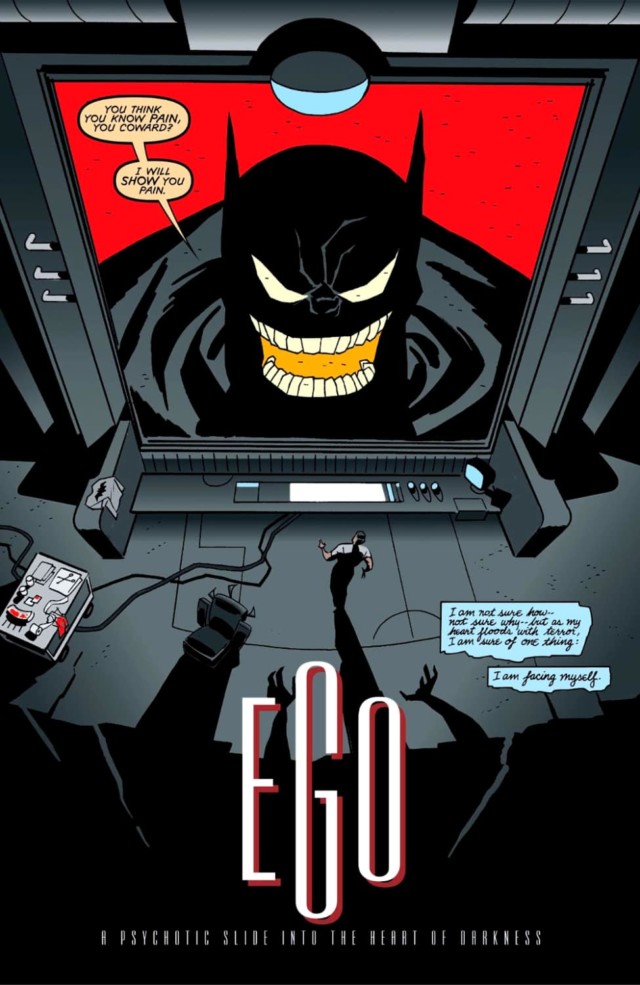
Bruce Wayne vs. Batman: The story of Ego
Batman: Ego was Darwyn Cooke’s comics debut and it’s a sensational start. Ego is a deeply powerful character study of Bruce Wayne’s psyche, exploring Bruce’s motivations for his mission and self-loathing for his failures. The story is set during “Year Three,” but it recaps the grand Batman myth so elegantly that Ego serves as an origin comic for both Batman and his most notorious foes. The story is easily accessible as a first Batman comic, presenting a concise yet thorough retelling of the classic Batman story through Darwyn Cooke’s unique point of view.
The comic spends more time with young Bruce and his parents than nearly any other Batman story, building the family dynamics and the Waynes’ relationships with each other. Letting the readers meet these characters before their tragedy allows us to deeply feel what was lost when Bruce’s parents died.
One of the true highlights of the narrative is the balance between the dark psychological terror of Batman and Bruce’s unyielding optimism for a better future. Ego is crafted so confidently and effortlessly that the only clue to Cooke’s inexperience with the comics medium is slight pacing struggles as the narrative transitions between story ideas. Otherwise, Batman: Ego is a high-quality comic from start to finish, and a phenomenal first achievement.
Batman: Ego was fully drawn, inked, and colored by Darwyn Cooke himself. Even though it was his first comic, his trademark cartoonist style is already present. However, compared to Cooke’s later work, he accentuates his style here with harsh jagged lines and a darker color palette which matches the mood of the story.
Cooke also took inspiration from the Batman: The Animated Series universe as well, which he worked on for years. The art of Ego goes hand-in-hand with Cooke’s script, and most of the storytelling is told visually rather than through the words on the page.
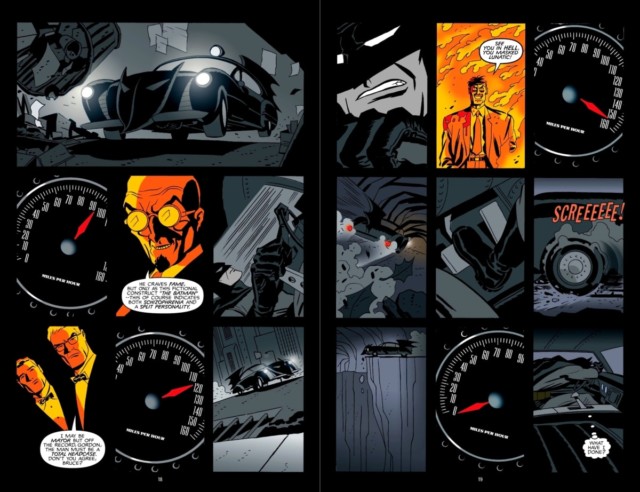
One of my favorite elements of the book is how Cooke does page layouts, balancing tidy grid panels with giant splash pages and clever visual tricks. It feels slightly reminiscent of the paneling in Watchmen, but of course, this was actually Cooke figuring out his own style, which he would later perfect with the three-panel grid in DC: New Frontier.
Jonathan Babcock’s lettering stands out the most with the cursive journal-style narration script. I was surprised that the demon Batman and the human Bruce Wayne have the same font face with only different speech balloon colors, but that could also be interpreted intentionally, to show how intertwined the two personas are.
In Batman: Ego, Cooke crafts a psychological story where Batman literally confronts his fear and inner demons. In the end he comes away with a profound resolution that encapsulates the magic of the Batman character, and proves what separates Bruce Wayne from being a ruthless anti-hero. As a result, the message of Ego shares DNA with some of the greatest Batman adaptations in history, like Batman: The Animated Series, Batman Begins, and The Batman.
However, as a lifelong fan of Batman across comics, movies, and TV, Ego felt a bit old hat to me. It felt like a story I knew too well already, and a story that has probably been explored better elsewhere. Ego is absolutely an important comic for Cooke’s career, and an exciting exploration of Batman, but it no longer feels groundbreaking. While the writing is interesting and the art is dynamic and beautiful, long-term fans might be underwhelmed by the familiar message at the heart of the book.
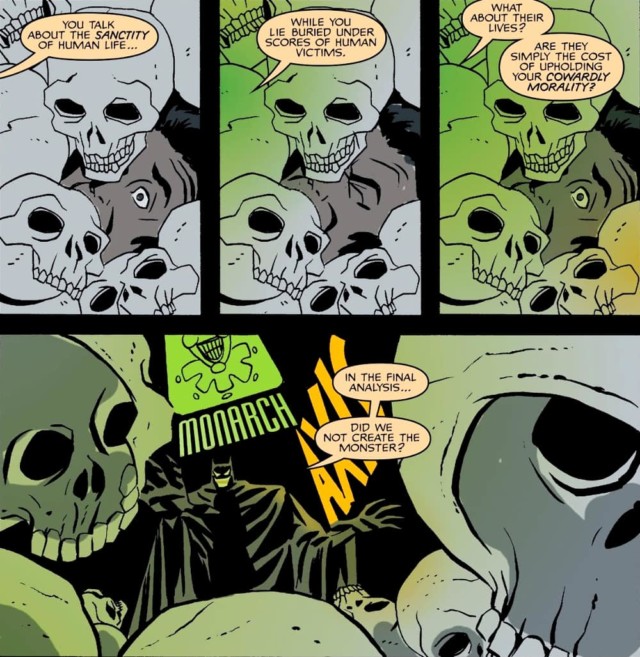
How to read Batman: Ego
Batman: Ego is a one-shot issue highly recommended for new readers, and totally accessible. It’s not connected to any comic universe or even the animated continuity. Ego is a completely standalone single story that begins and ends in just 64 pages. It’s so easy to read that Batman: Ego is one of my #1 picks for Batman fans who are new to comics.
The Batman: Ego and Other Tails trade collections include Ego, as well as almost every Batman story written by Cooke. The trades also tease some of his highly acclaimed Catwoman work too. There are two printings, from 2007 and a Deluxe Edition in 2017. I’ve looked at both, and there’s no question: get the Deluxe Edition! It includes everything from the 2007 version, plus even more stories and pieces of art. Considering that one of those additional stories is the multi-award-winning Batman/The Spirit #1, the new Deluxe Edition is definitely worth seeking out.
- Batman: Ego and Other Tails (2007 edition)
- Introduction by Darwyn Cooke
- Batman: Ego (2000)
- Batman: Gotham Knights #23 (“Here Be Monsters”, 2002)
- Catwoman: Selina’s Big Score #1 (2002)
- Batman: Gotham Knights #33 (“The Monument”, 2002)
- Solo #1, 5 (“Date Knight”, “Deja Vu” 2004-2005)
- Batman: Ego and Other Tails Deluxe Edition (2017 edition)
- Introduction by Amanda Conner
- Batman: Ego (2000)
- Batman: Gotham Knights #23 (“Here Be Monsters”, 2002)
- Catwoman: Selina’s Big Score #1 (2002)
- Batman: Gotham Knights #33 (“The Monument”, 2002)
- Solo #1, 5 (“Date Knight”, “Deja Vu” 2004-2005)
- Batman/The Spirit #1 (2006)
- Harley Quinn Holiday Special #1 (“Killin’ Time”, 2014)
- Afterword by Darwyn Cooke (reprinted from the Introduction of the 2007 edition)
After Batman: Ego, also check out Cooke’s other work like DC: The New Frontier and his transformative run on Catwoman!
Darwyn Cooke on screen
Batman: Ego itself would not work as a live-action movie, but could be possible as an animated short. Ego could have even been a great episode of Batman: The Animated Series, similar to how Mad Love was translated from page to screen. That being said, the ethos of Batman: Ego and the messages explored here are already present in the best Batman stories which analyze the dichotomy of Bruce Wayne and Batman.
Ego has had a major impact on so many Batman adaptations in recent years, and we can expect the trend to continue in the future of Robert Pattison’s The Batman saga. Probably Brave and the Bold as well, the first Batman film in James Gunn’s new DCU.
For more of Cooke’s work in film/TV, you can check out the episodes of Batman, Superman, and Batman Beyond which he storyboarded under the direction of Dan Riba. Cooke also designed the title sequence for Batman Beyond, which played in front of every episode. Later in his life, DC: The New Frontier was adapted as an Emmy-nominated animated film titled Justice League: The New Frontier. Although Cooke didn’t have major involvement, he was able to serve as a creative consultant on the film. The final product is a movie closely inspired by the story and art of the original, making it a good companion piece for Cooke’s DC: New Frontier comic book.
- Batman/Superman episodes storyboarded by Darwyn Cooke
- Batman: The Animated Series (The New Batman Adventures) (1996)
- S3 E11: “The Ultimate Thrill”
- S3 E14: “Critters”
- S3 E19: “Legends of the Dark Knight”
- S3 E23: “Beware the Creeper”
-
- Superman: The Animated Series (1998)
- S3 E03: “New Kids in Town”
- S3 E04: “Obsession”
- S4 E03: “Legacy: Part 2” (series finale)
-
- Batman Beyond (1999)
- S1 E03: “Black Out”
- S1 E08: “Dead Man’s Hand”
- S2 E02: “Earth Mover”
- S2 E06: “Bloodsport”
- S2 E08: “Hooked Up”
- S2 E13: “Terry’s Friend Dates a Robot”
-
- Justice League: The New Frontier (2008)
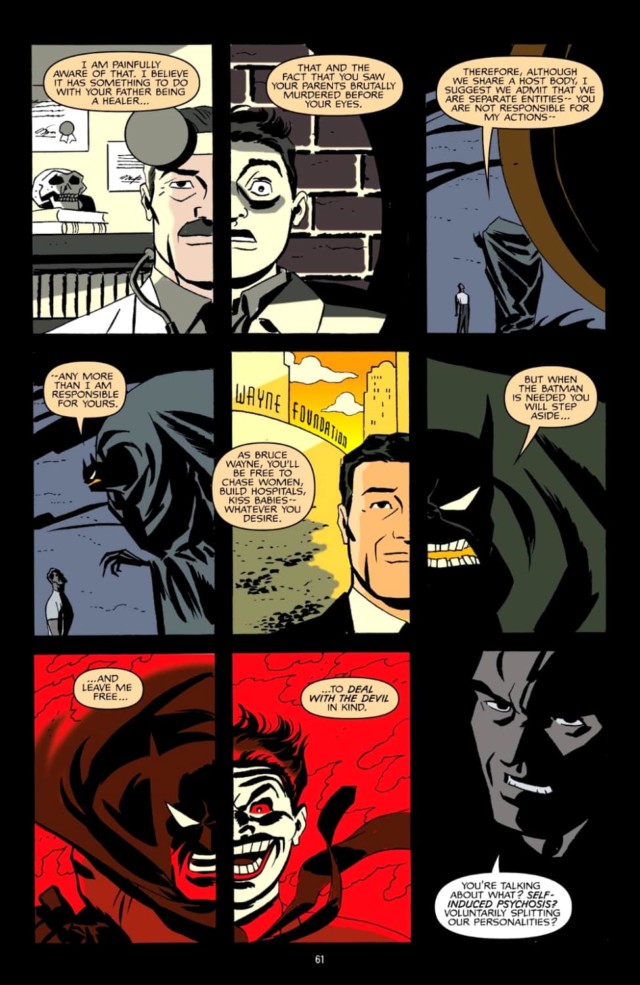
My verdict on Batman: Ego
Studying the dynamic between Bruce Wayne and Batman might seem unexciting these days, but that’s largely due to the monumental impact of stories like Batman: Ego. Ego’s biggest strength is not only how well Darwyn Cooke personified the division between Bruce and Batman, but also the power of his visual storytelling. Cooke’s art captured the twisted world of Batman’s nightmares in a way that was wonderfully cartoony yet appropriately gothic, perfectly portraying the two sides of Batman in a way that few stories had ever done before.
Batman: Ego isn’t a novel reinvention of Bruce Wayne’s psyche, but a deeper analysis of the iconic character we already know and love. After reading Ego, you will walk away with a richer understanding of Batman and his moral struggles and fears. This is one of the greatest stories to capture the internal dilemmas of Batman, and how strong this hero truly is. If you’re a new comics fan looking for a quick read, this is one of the best Batman stories you can find.
What’s your favorite Darwyn Cooke book? Are you excited to see more of Robert Pattinson’s Bruce Wayne/Batman dynamic in The Batman Part II? Let me know on Twitter @vinwriteswords and remember to follow the site @MyCosmicCircus for more comics coverage coming soon!
Check out our full list of DC comic reviews here, plus our review of Harley Quinn’s iconic origin story, Batman Adventures: Mad Love!
And if you love Batman: The Animated Series, be sure to read our moving tribute to Kevin Conroy, who will forever be the voice of Batman.

